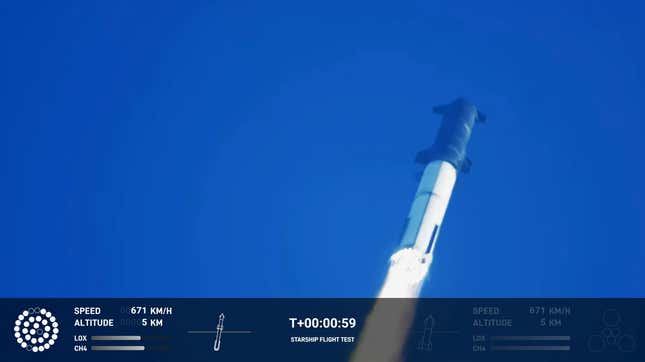It finally happened—and it was as spectacular as we hoped. SpaceX’s Starship megarocket blasted off from the Boca Chica, Texas, launch pad just after 9:30 a.m. ET this morning, lifted upwards by a record-breaking amount of thrust.
Starship is not yet ready for prime time, but by finally taking flight on Thursday, the megarocket is now in the record books as being the biggest, tallest, and most powerful rocket to take flight. This was a test flight, and SpaceX wanted to see just how far they could take it, so having the rocket last for nearly four minutes represents an incredible accomplishment.
Advertisement

Advertisement
The rocket cleared the launch tower and managed to survive MaxQ, the moment when a rocket experiences the greatest aerodynamic pressure, and continued upwards toward space. Things turned sour shortly before the four-minute mark, however, when the rocket began to exhibit erratic flight behavior. The rocket blew up, presumably the result of a self-destruct command issued by SpaceX ground control.
Advertisement
Starship was approximately 37 miles (60 kilometers) above the Gulf of Mexico when it began to tumble. As the Kármán line begins at 62 miles (100 km) above the surface, it cannot be said that Starship entered space. For this mission, SpaceX stacked Starship prototype 24 onto Super Heavy booster 7 prototype. Both elements were destroyed during the test flight, which failed shortly before the stage separation phase of launch.

Advertisement
Launch preparations, including the loading of 10 million pounds of cryogenic liquid propellant, unfolded this morning without any serious issues emerging. Shortly before launch, SpaceX commentator John Insprucker said teams managed to resolve a booster tanking pressurization issue, while also having to attend to some final purging in the upper stage. The launch was briefly put on hold at the T-40 second mark, allowing the teams to perform final checkouts.
The launched resumed shortly thereafter, with the methane-powered 33 Raptor engines igniting in banks, or clusters, the first set of which erupted at T-6 seconds. The rocket rose upwards, clearing the tower and producing an unusually sooty and brown plume.
Advertisement
As the rocket ascended, several bright flashes appeared at the base of the Super Heavy booster—a potential sign of some Raptor engines fizzling out during the launch. As many as three failed during the first 15 seconds, with another four or five failing deeper into the short-lived mission. A graphic shown during SpaceX’s live coverage, displaying several unlit Raptors, matched the visuals of the rocket itself.
Had all 33 Raptors ignited, the rocket would’ve produced approximately 16.5 million pounds of thrust. Still, with even a small portion of the engines not firing, the launch is sure to result in a new lifting-power record. We’re looking forward to SpaceX providing clarification on this, and the reason for the sooty plume. Starship also appeared to shimmy horizontally after clearing the tower, which also requires an explanation.
Advertisement
A concern heading into the launch was whether the jumbo rocket might cause damage to 469-foot-tall (142 meters) launch and catch tower and surrounding infrastructure. The launch site seems relatively unscathed, but we await further confirmation from SpaceX in the coming days.
Advertisement
Starship is a two-stage rocket that SpaceX will use to transport crews, cargo, and spacecraft to Earth orbit, the Moon, Mars, and other destinations. As the rocket is designed for complete reusability, and because it’s so powerful, Starship represents a revolutionary next step for heavy-lift launch vehicles. NASA has a vested interest in Starship, as the space agency is planning to use the upper stage as a veritable elevator for transporting crews down to the lunar surface during upcoming Artemis missions.
Advertisement
For the maiden flight of Starship, SpaceX had planned for the upper stage to fly as far as Hawaii and crash into the Pacific Ocean, and have the booster fall into the Gulf of Mexico. The mission lasted for four minutes and not the hoped 90 minutes, but this is still an amazing result.
SpaceX was simply hoping to see the rocket leave the Boca Chica launch tower, so everything that happened afterwards should be considered a bonus. That said, the inaugural flight did result in some very curious and potentially problematic behaviors that CEO Elon Musk’s private space company will have to sort out. SpaceX, it’s fair to say, still has a lot of work to do to make Starship a fully operational and reusable heavy-lift launch vehicle.
Advertisement
This article is part of a developing story. Our writers and editors will be updating this page as new information is available. Please check back again in a few minutes to see the latest updates. Meanwhile, if you want more news coverage, check out our tech, science, or io9 front pages. And you can always see the most recent Gizmodo news stories at gizmodo.com/latest.
Services Marketplace – Listings, Bookings & Reviews